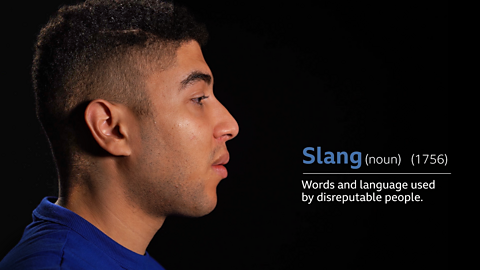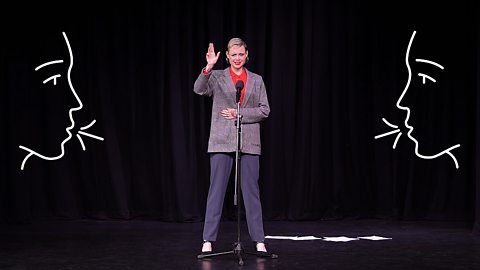What do you know?
Why might some people eat ‘dinner’ before ‘tea’ and others eat ‘tea’ before ‘dinner’?
In northern England ‘dinner’ is the word often used for a midday meal and ‘tea’ for an evening meal, but in southern England ‘tea’ is often a light afternoon meal and ‘dinner’ is the evening meal.
Introduction to accent and dialect
Key learning points
- The difference between accentHow we describe the sounds of a person’s speech. and dialectThe words and grammar that a group of people use. The group are usually from a specific area or place..
- The brilliant variety of accents and dialects in the English language.
- The ways writers can use dialects in fiction.
Video about accent and dialect
A video about accent and dialect and how these can make words sound different and have different meanings when said by people from different places
Your accent and your dialect both carry clues about the places that have influenced you most – places where you’ve lived, or the voices you’ve heard growing up.
Your accent is how you pronounce words, which parts do you stress or pitch? For example, how would you say this?
In Somerset, people would say it’s ‘bath’, with long vowels.
But in Leeds, it would be ‘bath’. Note the short vowels. It’s the same with (short A) giraffe.
Which may even make you ‘laugh’ or ‘laugh’ of course (long A as in ‘larrrff’). It just depends on your accent, there is no ‘right’ or ‘wrong’.
Dialect is also linked to location, but this time it’s about the vocabulary and grammar you use. For example, how would you ask for one of these?
Here are just some of the possibilities…
“Alright, can I have a chip barm cake please?” (Salford)
“Chips on a tea-cake please!” (Barnsley)
“Aye a chip roll please?” (Ayrshire)
“No, on a bap!” (Belfast).
“What about a cob?” (Nottingham)
“Alright there mate, can I get a chip batch please?” (Coventry)
“Chips on a roll, a chip butty please!” (London)
“Ooh, on a roll sounds lush” (Swansea)
“On a bun, man!” (Gateshead)
And that’s not even all of them. It could be a muffin, a batch, a bread cake, a scuffler, and that’s just these lumps of bread! Try words for babies or friends, happy, sad, tired, lucky. Just like accents, people speak differently across the UK, and so a dialect is neither right nor wrong.
Narrator (referencing the burp): Although that is wrong, for most people.
What is an accent?
Accent describes the sounds of a person’s speech. We all speak with an accent if we use our voice to talk (don’t use the word ‘accent’ to describe speaking with sign language, as this doesn’t include sound). Your accent affects the way you pronounce words. For example, different people might pronounce the word ‘scone’ in different ways. Scone could rhyme with ‘cone’ or with ‘gone.’
Which pronunciation do you use?
Often, differences in accent are linked to where people live and where they grew up.
What is dialect?
As well as accent (pronunciation), different people might use different words and grammar. This is called dialect. For example, there are lots of different words that people use for a bread roll:
- Bap
- Barm / barm cake
- Buttery
- Cob
- Morning roll
- Stottie
- Teacake
Different dialects also include differences in grammar. For example, the standard past tense of ‘I am’ is ‘I was’. However, in some dialects in northern England, speakers might say ‘I were’. There isn’t a right and a wrong here, they are just different dialects.
Standard English
Standard English is the name for a dialect of English that is widely understood and tends to be used in writing and in formal situations. It isn’t linked to a particular part of the UK.
This is the type of English that you will usually be expected to use in your writing at school. There are rules that should be followed when writing in standard English, for example:
- ‘Is not’ or ‘isn’t’ instead of ‘ain’t’
- ‘She does not’ or ‘she doesn’t’ instead of ‘she don’t’
- ‘I was’ instead of ‘I were’
Standard English isn't the only ‘correct’ variety of English, but it is the type of English that is expected in written school work. All varieties of English are just as good as each other.
You might expect Standard English to be spoken with a particular accent, but there is no specific accent linked to the dialect. If you are thinking of an accent similar to the Queen’s accent, this is received pronunciationThe standard form of British English pronunciation.. This is an accent, but it is not the same as Standard English, which is a dialect. Standard English can be spoken with a variety of different accents.
Accents and dialects as variety
Everyone speaks with an accentHow we describe the sounds of a person’s speech. and a dialectThe words and grammar that a group of people use. The group are usually from a specific area or place., but some regions of the UK are associated with particularly recognisable accents and dialects. Some that you might be familiar with include:
- Liverpool (also called Scouse)
- Newcastle (also called Geordie)
- Somerset
These regional varieties often include features of accentHow we describe the sounds of a person’s speech. and dialectThe words and grammar that a group of people use. The group are usually from a specific area or place. which make them different from Standard English.
Connection between dialect and identity
The way we speak is a big part of our identity. Accent and dialects can reflect where people come from and how they want to be seen. Lots of things can have an effect on the way we speak:
- region
- age
- education
- social groups
- gender
- ethnicity
Your own particular way of speaking is a result of all these different influences, and is called your idiolectAn individual's unique variety of speech habits.. It is really important not to judge a person based on the way they speak, just as it is important not to judge them by their appearance.
Dialect in fiction
Writers can use different dialect varieties to help them create characters in fiction. Using a non-standard dialect can help give a reader a sense of the character’s voice and perhaps an idea of where they are from.
Harper Lee uses a regional dialect to suggest the Alabama setting and the young age of her narrators in To Kill A Mockingbird:
“You look right puny for goin’ on seven.”
Mark Twain uses regional dialect to create a recognisable voice for his main character in Adventures of Huckleberry Finn:
“All I wanted was to go somewheres; all I wanted was a change, I warn’t particular.”
In Northern Lights, Philip Pullman uses non-standard dialect to show the difference between the younger characters and the older characters, who speak in a more standard dialect. Here is an example of Lyra and Roger, two younger characters:
“You’re afraid of ’em”, she said. “I can tell”.
“I en’t. I don’t believe in ’em anyway”.

Try to rewrite these examples of non-standard dialect into standard English.
“You look right puny for goin’ on seven.”
“All I wanted was to go somewheres; all I wanted was a change, I warn’t particular.”
“You’re afraid of ‘em”, she said. “I can tell”.
“I en’t. I don’t believe in ‘em anyway”.
Answers:
“You look really puny for nearly seven”.
“All I wanted was to go somewhere; all I wanted was a change, I wasn’t particular”.
“You’re afraid of them”, she said. “I can tell”.
“I’m not. I don’t believe in them anyway”.
Test your knowledge
Play Bitesize secondary games. gamePlay Bitesize secondary games
Have fun playing science, maths, history, geography and language games.

More on Spoken English
Find out more by working through a topic
- count4 of 5

- count5 of 5

- count1 of 5

- count2 of 5
